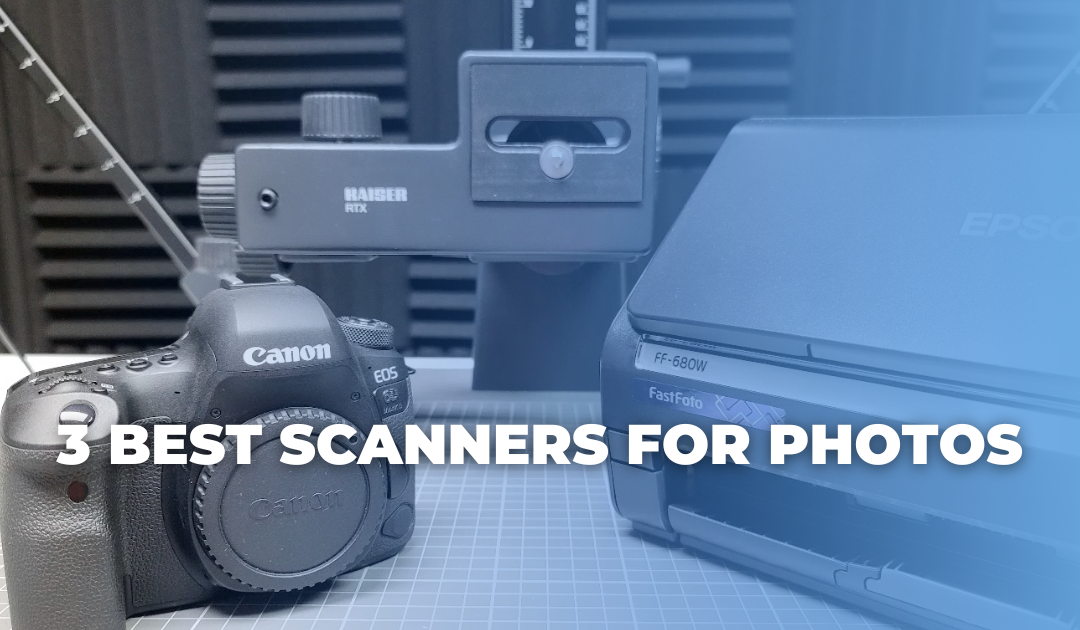Scanners have come a long way. There are a lot of options out there and they’re relatively easy and affordable to purchase at local stores and online. But when you’re trying to scan and digitize old photos, choosing the right scanner can feel overwhelming.
Not all scanners are created or operate equally. As professional photo organizers, we’ve seen and heard about many different models.
If you’re considering a scanner purchase – be it for scanning photos, letters, kids’ artwork, or memorabilia – these are our top recommendations.
Best Overall Flatbed Scanner: The Epson Perfection V600 Photo Scanner
Quick facts about the Epson Perfection V600 Photo Scanner:
- A favorite of our Facebook group members
- Scans at up to 6400 x 9600 DPI
- Perfect for photos, slides, and negatives
- Removes photo imperfections like tears, creases, and dust from final scans
If you own an all-in-one home printer, it probably includes a top that looks like a photocopier. These machines are relatively easy to use: An item is placed face down on a glass plate and a scanning array captures the image from below with the push of a button. Flatbeds work very well with flat, single-page items, including things like photo negatives and slides.
If you plan to scan only a few hundred photos, this is an excellent option. However, if you are going to scan your entire collection, software glitches typical to these home printers could make finishing your work troublesome.
Additionally, while flatbed scanners can also be used to scan bound materials, this subjects the binding to stress and may cause damage. Bear this in mind when scanning from books or albums.
Best Overall Feeder Scanner: FastFoto FF-680W Wireless High-Speed Photo Scanning System
Quick facts about the FastFoto FF-680W Wireless High-Speed Photo Scanning System:
- Scans photos of various sizes, up to 8 x 10 inches
- Can scan up to 35 photos per minute with its “bulk scan” feature
- Automatically allows you to upload your scans to cloud-based services like Dropbox and Google Drive
Feeder scanners are great if you’re scanning and organizing a large number of photos. Unlike a flatbed scanner where you must lay photos on the scanning glass one by one, feeder scanners allow you to “feed” your images into the machine at a rapid rate. There’s no need to do them one at a time – it pulls photos in one end, scans them quickly, and deposits them out the other side.
One obvious downside to a feeder scanner is that they can only scan single photos or documents; there’s no way to scan bound materials short of removing a page from a book or album. If you’re unable to remove individual pages from your current bound collection, a feeder scanner might not be the right choice.
Moreover, storing feeder scanners properly is a big deal. They can be difficult to keep clean and are not good for delicate photos, negatives, or slides.
Best Overall Overhead Scanner: Fujitsu ScanSnap SV600
Quick facts about the Fujitsu ScanSnap SV600:
- Scans images and documents up to size A3 (11.7 x 16.5 inches)
- Excellent option for scanning bound materials like books and photo albums
- Can scan and detect multiple separate items in a single scan
An overhead scanner is another great option and is perfect if you need to scan newspapers, magazines, books, or documents in addition to photographs.
The ScanSnap SV600 VI has a multi-document detection feature that enables you to scan multiple business cards, photos, newspaper clippings, or other documents in a single scan, automatically cropping and rotating the scanned images.
While this scanner has a lot of great benefits and features, the software has a steep learning curve. If you’re new to scanning or don’t consider yourself particularly technologically savvy, this might not be a good option for personal use. It’s also not ideal for large photo collections.
Do you really need a scanner? Maybe not!
Here’s something that might surprise you: There’s an app for that! You don’t even need a scanner to scan and digitize your photos.
But while apps may be insanely cheaper than buying or renting a scanner, smartphone cameras will not produce the quality that a scanner guarantees. The scanning process also takes longer as you can only scan one print at a time, just like with a flatbed scanner.
The two most popular smartphone scanning apps are Photomyne and PhotoScan from Google. These allow you to use your smartphone’s camera to scan and save your pictures. Both apps offer further organization through cloud storage options.
You can download a free trial of Photomyne or pay a monthly fee to experience the full extent of tools available, including retouching and sharpening tools, through the app. Alternatively, PhotoScan is free.
Scan Like a Pro
There are many options when it comes to scanning photos, and each one has its benefits and drawbacks. But depending on the size and scope of your scanning project, you don’t necessarily need a scanner to get the job done. Knowing your options is the best way to determine which scanning solution is right for you.
Want an alternative to scanning photos with a traditional scanner? Check out our self-paced Camera Scanning Simplified course.


Recent Comments